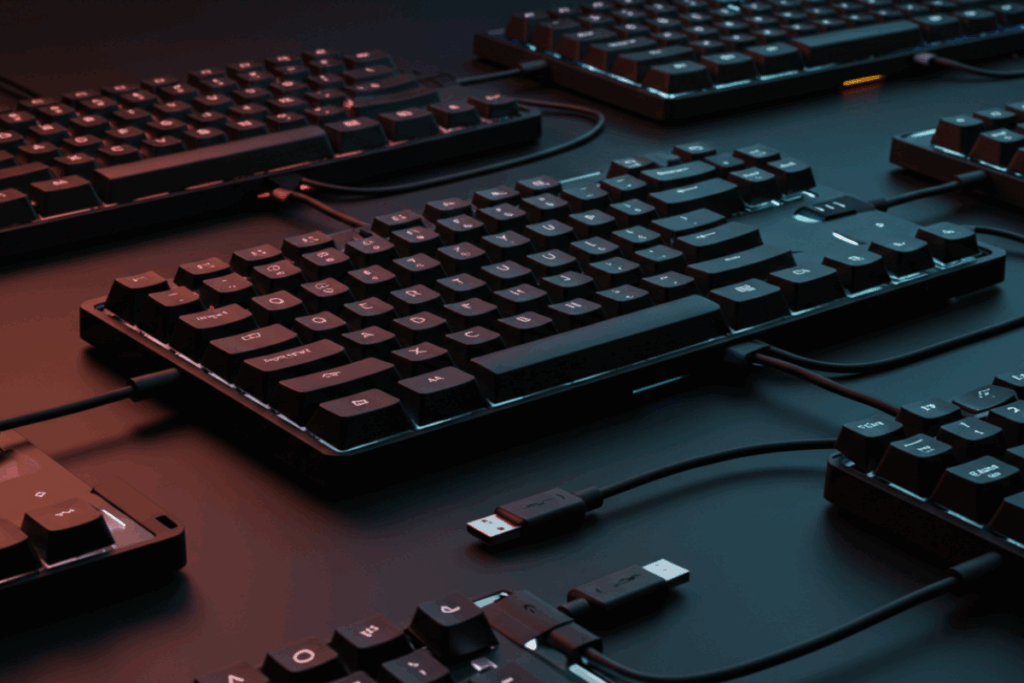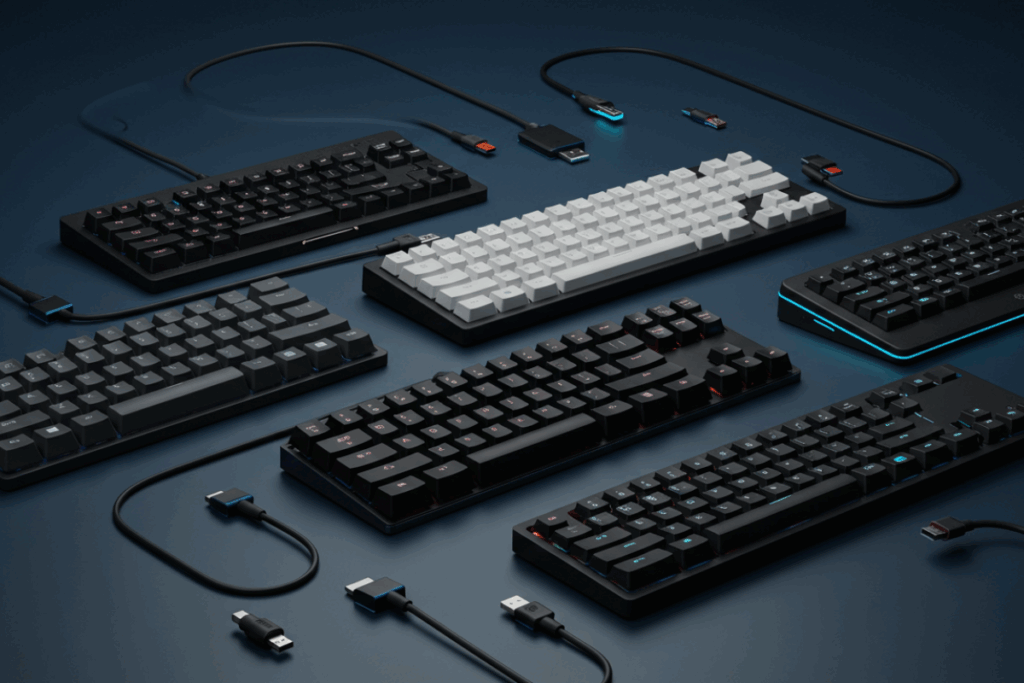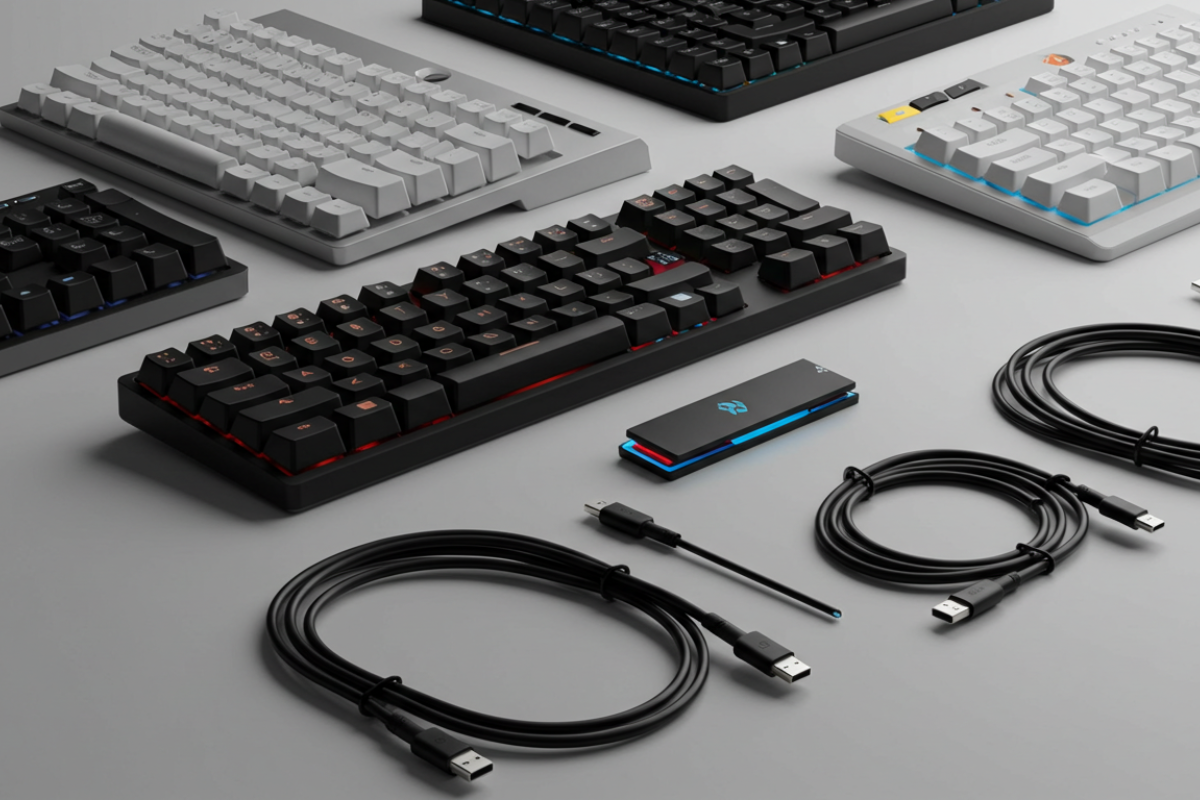Keyboards with detachable cables let you unplug the cord for easy travel, quick swaps, and simple fixes. I write for Keyboards Technology, and I favor these boards for portability, customization, maintenance, and wide compatibility.
This guide shares my top picks and the criteria I use — build quality, connector type (USB‑C, TRRS, micro‑USB), connection stability, aesthetics, price/value, and overall compatibility — so you can pack, play, and personalize with confidence.
Key Takeaway
- I prefer keyboards with detachable cables for tidy desks and easy travel.
- USB‑C detachable cables are my default for future‑proofing.
- Look for hot‑swap sockets, PBT keycaps, and tight cable fit.
- Good build quality and stable firmware matter more than RGB.
- I rely on Keyboards Technology for reliable builds and support.
Why I Prefer Keyboards with Detachable Cables for Travel
I travel often and bring a keyboard on most trips. Keyboards with detachable cables save space and reduce stress: coil the cable, keep it in a pocket, and avoid bent pins or loose wires. A detachable cable makes packing faster and gear neater — small habits that prevent damage and speed setup.
How I Pack Portable Keyboards with Detachable Cables
- Unplug the cable and coil it loosely; secure with a small velcro tie.
- Slide the cable into a padded pocket, keyboard flat between clothes for padding.
- Carry a spare zip bag for adapters and a microfiber cloth between keycaps and other items.
- Prefer soft-sided cases when saving space matters.
Choosing Compact Keyboards with Detachable USB‑C Cable for Carry‑On
I pick compact boards that fit a small carry‑on and use a detachable USB‑C cable. USB‑C is slim, reversible, and widely available — easy to replace if lost.
| Feature | Why I care | What I look for |
|---|---|---|
| Size | Saves room | 60–75% layout or foldable |
| Cable type | Fast, simple connection | USB‑C detachable |
| Case | Protection low weight | Soft case with padding |
| Weight | Less strain while walking | Under 1 kg if possible |
| Build | Lasts through travel | Solid frame, balanced weight |
I test-fit the keyboard in my bag before buying. If it slides in next to my laptop and charger, it passes.
Top storage tips
- Wrap the cable loosely to protect connectors.
- Use a padded sleeve or soft case.
- Store flat, not on edge, to avoid pressure on switches.
- Keep a small packet of silica gel to reduce humidity.
How I Evaluate Build and Switch Options on Keyboards with Detachable Cables
I test hot‑swap boards with a detachable cable to ensure easy maintenance. I look for firm sockets, stable cable ports, and even travel across the board.
| Test | What I watch for | Why it matters |
|---|---|---|
| Hot‑swap action | Socket tightness, ease of pull | Bad sockets ruin switch feel |
| Cable fit | Firm plug, strain relief | Loose cable = disconnects |
| Switch swaps | Fit, no bent pins | Bent pins mean dead switches |
| Sound samples | Tone, volume | Helps choose switches |
| Key rollover | Full NKRO | For fast typing and gaming |
Case materials and feel
- Aluminum: bright, ringing, solid — higher price.
- Plastic: muffled, lightweight, budget friendly.
- Gasket mount: dampened, warm, soft bounce.
Quick checklist (pass/fail)
- Switch smoothness: consistent travel vs scratchy bump.
- Stabilizers: minimal rattle vs loud wobble.
- Case fit: tight seams vs visible gaps.
- Cable port: tight hold vs loose wiggle.
- Firmware: quick programming vs crashes/limits.
How I Pick the Right Connector for Keyboards with Detachable Cables
I usually choose compact keyboards with detachable USB‑C cables. USB‑C is reversible, common, and easy to replace. I still use TRRS for split builds and micro‑USB for cheap backups, but USB‑C is the future‑proof default.
| Connector | Main benefit | When I pick it |
|---|---|---|
| USB‑C | Fast, reversible, common | New compact boards, travel |
| micro‑USB | Cheap, common on older gear | Budget/legacy boards |
| TRRS | Simple for split keyboards | Split or DIY layouts |
Rules I follow:
- Pick USB‑C for new boards.
- Choose detachable cables for easy replacement.
- Use TRRS only for split halves.
- Use micro‑USB for inexpensive spares.
- Carry one multi‑purpose USB‑C cable and check pinouts before using adapters.

How I Choose Keyboards with Detachable Cables for Gaming and Performance
I choose keyboards with detachable cables for flexibility and clean setups. For gaming, I check latency, polling rate, and real‑world performance. I favor TKL layouts for more mouse room and fast response.
Polling, latency, and cable considerations
I want 1000Hz polling for pro‑level response. I prefer USB‑C detachable cables for firm connections and low signal loss. I verify advertised specs with in‑game tests.
| Polling rate (Hz) | Approx. latency (ms) | When it matters |
|---|---|---|
| 125 | 8 ms | Casual play, typing |
| 250 | 4 ms | Light competitive |
| 500 | 2 ms | Competitive gaming |
| 1000 | 1 ms | Pro play, fast FPS |
Layouts for gaming
- Full: more keys, larger footprint — not ideal for tight mouse space.
- Tenkeyless (TKL): preferred for gaming; more mouse area.
- 75% / 60%: very compact, depends on workflow.
Performance checklist:
- Stable 1000Hz polling under load.
- Full N‑key rollover (NKRO).
- Debounce around 4–8 ms, typically ~5 ms.
- Tight USB‑C cable fit; minimal slack with short cables.
How I Find Budget‑Friendly Keyboards with Detachable Cables That Still Deliver
I hunt for reliable value: durable boards that type well and are easy to repair. I often start with Keyboards Technology‘s budget detachable models because they balance price and durability.
| Pick | Where it shines | Price range |
|---|---|---|
| Keyboards Technology budget detachable | Solid build, good stabilizers, real USB‑C | $30–$60 |
| Hot‑swap 60% with detachable cable | Switch swaps later, compact | $40–$80 |
| TKL with detachable cable | Work keys compact | $45–$90 |
Where I compromise and where I spend:
- Compromise on RGB and flashy software.
- Spend more on PBT keycaps, hot‑swap sockets, and a solid detachable USB‑C cable.
- Invest time in stabilizer tuning — high impact, low cost.
Buying checklist:
- Port type: USB‑C detachable preferred.
- Keycaps: PBT over ABS.
- Switch type: hot‑swap if you want to experiment.
- Stabilizers: pre‑lubed or easy to mod.
- Warranty/support: fast brand support.
How I Customize and Maintain Custom Mechanical Keyboards with Detachable Cables
I enjoy modding because a detachable cable makes swapping fast. I test three switch families — tactile, linear, clicky — and use sound samples to compare.
| Switch Type | Feel | When I use it |
|---|---|---|
| Tactile | Bumpy | Typing, mixed use |
| Linear | Smooth | Gaming, speed typing |
| Clicky | Loud | Typing with strong feedback |
Keycap choices affect sound and comfort: PBT for durability, ABS for shine. Profiles like Cherry and SA change hand position and tone.
Recommended accessories:
- Coiled cables for desk aesthetics; straight for travel.
- Solid cases (aluminum or dense plastic) for stability.
- Keep spare PBT keycaps and a trusted detachable cable pouch.
Maintenance routine:
- Unplug the cable and remove keycaps before cleaning.
- Use compressed air, wipe the case with a damp cloth, wash PBT caps in mild soapy water.
- Weekly: dust ports and under keycaps.
- Monthly: deep clean keycaps; inspect cable braid.
- Every few months: check connector pins and use contact cleaner if needed.
Store spare cables in a soft pouch; avoid sharp bends and heavy weight on cords. Log mods to revert if needed.

Conclusion
I’ve tried many boards; keyboards with detachable cables consistently win for portability, customization, and maintenance. I favor USB‑C for future proofing, choose PBT keycaps and hot‑swap sockets when possible, and always check build quality, cable fit, and firmware stability before buying.
Coil cables loosely, use a soft case, and keep ports dust‑free — small habits that keep gear sounding and feeling great. For performance, chase stable 1000Hz polling and snug connectors; for budgets, prioritize a firm USB‑C port and solid stabilizers over lights.
Frequently Asked Questions
Q: Which Keyboards Technology models top the list of keyboards with detachable cables?
A: I prefer Keyboards Technology’s recent compact and TKL models — they tend to offer firm USB‑C ports, decent stabilizers, and good support.
Q: Are keyboards with detachable cables as sturdy as fixed‑cable ones?
A: Yes — when well made. A quality detachable connector and good strain relief deliver durability comparable to fixed‑cable boards.
Q: Can I swap any cable on keyboards with detachable cables?
A: Only if the connector matches (USB‑C to USB‑C, TRRS to TRRS, etc.) and the pinout is correct. Using OEM or verified cables avoids compatibility issues.
Q: Do keyboards with detachable cables make travel easier?
A: Absolutely. They pack neater, reduce stress on connectors, and let you carry spare cables separately.
Q: How should I care for keyboards with detachable cables to keep them working?
A: Unplug gently, keep cables in a pouch, dust ports regularly, clean keycaps, and check connector pins periodically. Good storage prevents most problems.

